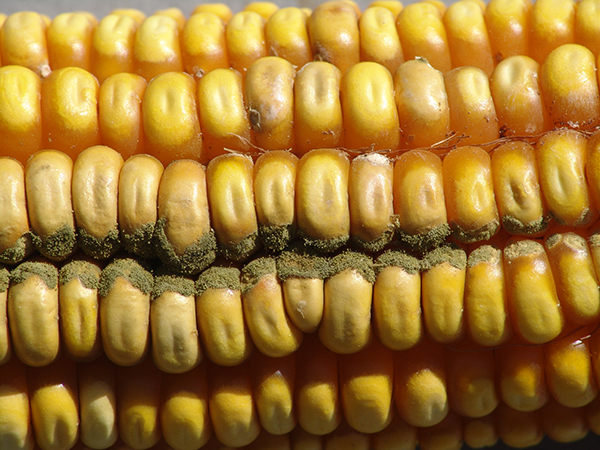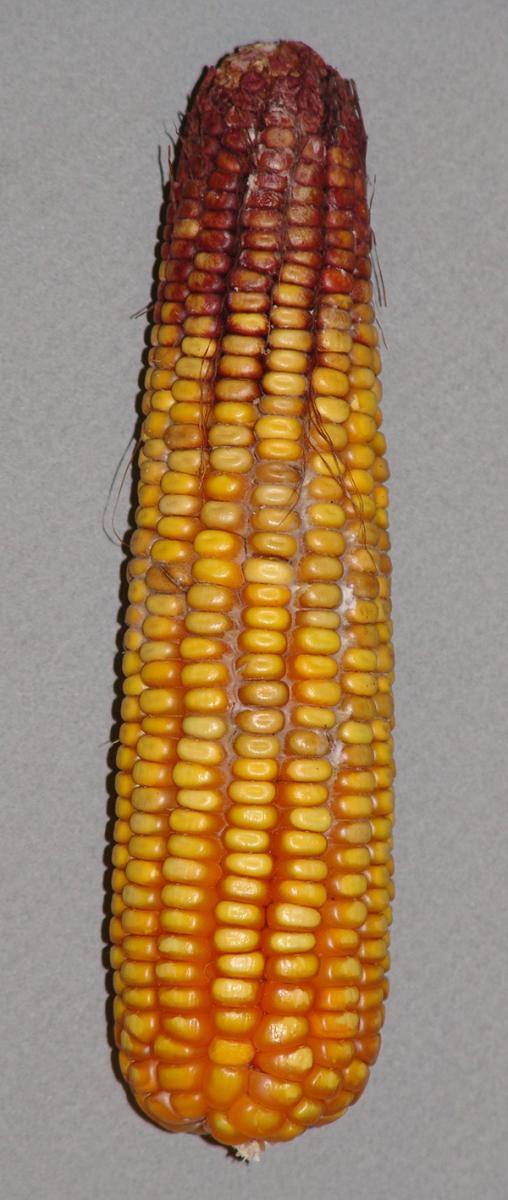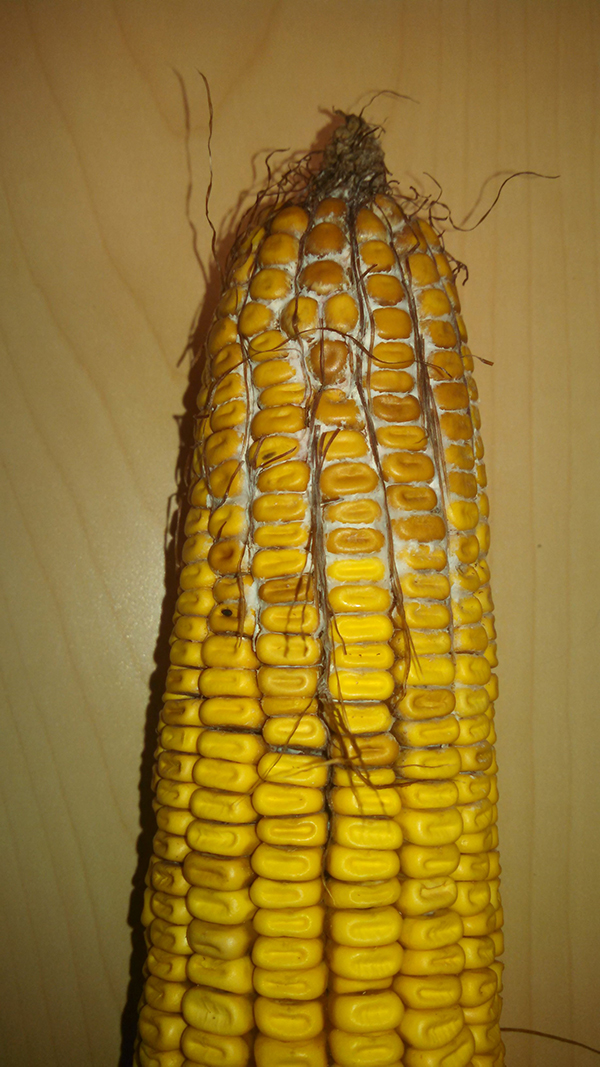
A few common ear rot diseases have begun to develop in corn fields in various parts of Nebraska. We recommend scouting fields prior to harvest to determine which fields may be affected. Corn fields at increased risk for ear rot diseases are those with ears that may have been injured by insect or hail damage, fields that may have received too much or too little water, or those in continuous corn, among others. Ear rot diseases are caused by fungi that can cause degradation of grain quality during storage and sometimes produce mycotoxins, depending upon which fungi are present. Harvest and storage conditions can impact whether grain molds will continue to worsen. Descriptions of several ear rot diseases found in Nebraska follow.
Gibberella Ear Rot
Also known as “red rot,” Gibberella ear rot is caused by the fungus Gibberella zeae(Fusarium graminearum). This pathogen overwinters on corn and wheat debris. Spores produced on the debris infect the plant at the silking stage via wind and rain splash which is why this disease is more common when cool, humid conditions occur.



White to pink-red mold, often starting at the tip of the ear (Figure 1), is common for this disease. The fungus may gradually move toward the base during grain fill, sometimes causing extensive damage. If not controlled, it may result in widespread kernel rotting and husks adhering tightly to the ears.
This disease results in direct loss of yield due to ear rot, as well as the possible production of mycotoxins, such as deoxynivalenol (DON) and zearalenone, in the infected kernels. Both of these can affect animals consuming them, particularly swine.
Fusarium Ear Rot
This ear rot disease is caused by the fungus Fusarium verticillioides. This pathogen overwinters in corn residue, and it can infect the germinating seed and move up the plant through systemic growth. Additionally, the fungus also produces spores, increasing the chances of infection via wind or rain splash. Fusarium ear rot (Figure 2) results in white to pink mold, particularly on the tip of the ear or wounding sites. Afflicted kernels may also have white lines radiating out on the cap of the kernel, often referred to as the "starburst" symptom. In severe infections, boosted by wet and warm conditions, ears may be completely consumed by the fungus, leaving lightweight husks covered by the mold. Infection is most common in ears damaged by insects with the plant being especially vulnerable soon after pollination. The pathogen can produce the mycotoxin fumonisin, which can affect both human and livestock consumers.
Aspergillus Ear Rot

Aspergillus ear rot has not been confirmed on samples from Nebraska in the University’s Plant and Pest Diagnostic Clinic this year; however, it is developing at a higher incidence than usual in some Kansas fields following the dry growing conditions of 2017. This ear rot disease is caused by several Aspergillus fungus species, such as the mycotoxin-producers Aspergillus flavus, A. parasiticus, and A. niger. This fungus overwinters in the soil, as well as on decaying plant material.
Aspergillus ear rot is characterized by the formation of powdery masses of spores on the kernels, occurring close to the ear tip or wounding sites. Appearance may vary according to the species of Aspergillus (Figure 3). For example, A. niger will show a distinctive black coloration, while A. flavus will show an olive-green color, along with seed discoloration and rot. Hot and dry weather, coupled with wind and insect damage, increases the chances of disease. Aspergillus ear rot not only affects marketability in terms of quality, but also its safety. Some Aspergillusspecies can produce a mycotoxin called aflatoxin, a potential carcinogen, which can accumulate as the fungus spreads. The disease and aflatoxin are more common in drought-stressed corn.
Diplodia Ear Rot
This ear rot disease is caused by the fungus Stenocarpella maydis (syn. Diplodia maydis). The fungus typically overwinters in corn debris from previous seasons, with infection occurring about two weeks prior to and after silking. This rot, favored by warm and wet weather, not only affects grain quality, but also may result in early plant death, impacting yield potential.
Losses may be higher in years when rainfall is above average from silking to harvest or when there is insect or bird damage. The ear leaf and husks on the ear of infected plants may appear bleached or straw-colored due to a dense light gray mold, matted between the kernels and between the ear and the husks. Mold growth will characteristically begin at the base of the ear, continuing toward the tip (Figure 4). If left in the field, infections may exacerbate, resulting in mummified, lightweight ears.
Unlike other ear rots, described here, the fungus causing Diplodia ear rot has not produced mycotoxins in the United States.

 Figure 4. Diplodia ear rot is a common ear rot disease favored by cool, damp conditions. Infection is usually evident at the base of the ear (left, Figure 4a) and can quickly spread throughout, leaving a mummified, lightweight ear. Black pycnidia (Figure 4b) are a diagnostic feature of the pathogen and disease.
Figure 4. Diplodia ear rot is a common ear rot disease favored by cool, damp conditions. Infection is usually evident at the base of the ear (left, Figure 4a) and can quickly spread throughout, leaving a mummified, lightweight ear. Black pycnidia (Figure 4b) are a diagnostic feature of the pathogen and disease.Managing Ear Rot Diseases To Minimize Losses
- Prior to planting, remove debris (particularly husks with black dots) from previous seasons. Tilling infected residue speeds decomposition and reduces inoculum.
- Crop rotation can decrease the amount of overwintering inoculum in the field. However, avoid crop rotation with wheat as it may also be a host for the pathogen causing Gibberella ear rot (e.g., Gibberella zeae). Soybean is a good rotation crop not known to be a host of ear rot pathogens.
- Minimizing stress during the growing season can help maintain plant quality and decrease the effects of ear rots. Irrigation and appropriate fertilization greatly reduces the incidence of several fungi. Injury sites caused by insect feeding will increase the chances of disease. Managing insect pests such as western bean cutworm will reduce infection of the ear.
- Consider storage of the highest quality corn. Corn affected by ear rot diseases should be stored for the least amount of time, or not at all. To avoid extending contamination, it should not be mixed with higher quality corn. Growing corn varieties resistant to ear rots is the most practical and cost-effective approach to managing ear rots, especially in areas where these diseases have been a problem.
- Storing corn in clean bins at low moisture (<15%) reduces the potential spread of molds in storage, maintaining the quality and safety of your grain.
Diagnosis
If you find ears with symptoms of ear rot diseases and need help identifying the cause, collect samples from different locations in the field and submit them to the University of Nebraska-Lincoln Plant and Pest Diagnostic Clinic for analysis. The Clinic can identify ear rot diseases, but does not provide mycotoxin analysis as a service. If you want a mycotoxin analysis, contact a service provider certified and listed by the U.S. Grain Inspection, Packers and Stockyards Administration (GIPSA).
Related Resources
For more information on ear rot diseases or mycotoxins see these university publications.
Ear Rots
- Nebraska Extension Corn Disease Profiles, photo guides with brief management information on foliar, stalk rot and eat rot disease.
- Ear Rots (CPN-2001), a publication of the Crop Protection Network.
Mycotoxins
- Mycotoxin FAQs (CPN-2002), a publication of the Crop Protection Network.
References
American Phytopathological Society (APS). 2016. Compendium of Corn Diseases, 3rd ed. APS Press, Urbana-Champaign.
UC Pest Management Guidelines. 2008. How to Manage Pests - Corn: Fusarium Ear Rot.
University of Illinois. 2010. Diplodia Ear Rot Making a Reappearance. No. 18 Article 3.
University of Missouri. 2014. Ear and Kernel Rots of Corn. Integrated Pest Management